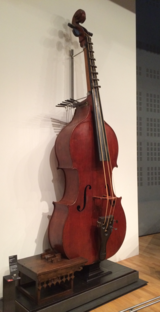Octobass
| Octobass | |
|---|---|
| English: octobass , French: octobasse | |
| Octobass by Jean-Baptiste Vuillaume in the Musée de la Musique, Paris | |
| classification | String instrument |
The octobass (occasionally also octobass) is the largest string instrument. It is tuned an octave lower than the violoncello ; The structure and playing technique, however, correspond to that of a large double bass . There are only a few historical and modern copies of this instrument.
construction
The octobass is a huge double bass with three strings . They are tuned in a fifth and a fourth , namely in C, G and C of the contra-octave (a concert grand piano goes three semitones lower). The highest string of the instrument is thus tuned as a capital C like the lowest string of a violoncello. The instrument is 3.45 meters high and weighs over 100 kg.
As with the double bass, the strings are bowed with a bow , whereby the player must stand on a pedestal to which the instrument is also attached. Since the fingerboard is too long to press the strings down with the fingers of the left hand, this is done using seven brackets that can be moved using levers at the beginning of the neck and foot pedals on the pedestal. Playing techniques such as vibrato and glissando are not possible with it.
history
The origin of the octobass goes back to the year 1850. The experimental French violin maker Jean-Baptiste Vuillaume created the instrument in collaboration with the composer Hector Berlioz , who wanted a bass instrument that would sound even fuller for one of his works. The Octobass was first used successfully in Charles Gounod's Cäcilienmesse in 1855. Hector Berlioz and Richard Wagner expressly recommended the use of the instrument, but neither wrote a score for the octobass.
Hector Berlioz wrote in his instrumentation theory :
“Mr. Vuillaume, violin maker in Paris, whose excellent violins are very much in demand, has enriched the stringed instrument family with a beautiful and powerful individuality: the octo: bass. This instrument is not, as many people believe, the lower octave of the double bass; it is the lower octave of the violoncello and can only reach the third below the E of the double bass to four strings. It has only three strings tuned in the fifth and fourth: - Contra C, Contra G, and capital C. "
Contemporary representations show that the instrument required two players: one to wield the bow and the other to grip the strings - the latter from a podium to which the instrument was firmly attached. The handles were carried out with the help of attached levers and pedals, not with the fingers.
The invention remained a curiosity. Vuillaume built three instruments: the first octobass was sold to an unknown private individual after the world exhibition in London in 1851 . He passed the instrument on to the English Opera in London, where it was destroyed in a fire in December 1867. A second Octobass, built for the World Exhibition in Paris in 1855 , was sold to Monaco. The Paris Conservatory later bought the instrument back. Today it can be seen in the Cité de la musique in Paris. The third Octobass went to Saint Petersburg. In the 1880s, the instrument came to the Viennese violin maker Zach senior in an unexplained way and then to the Salzer collection. The Gesellschaft der Musikfreunde in Vienna acquired the octobass in 1924. Today it is exhibited in the archive of the Musikverein.
Usage today
Between 1995 and 2002, the Italian musician Nicola Moneta performed with a recreated octobass.
In 2010 the Orchester Symphonique de Montréal had another replica made under the direction of Kent Nagano and used it in a performance of Richard Strauss ' symphonic poem " Ein Heldenleben ". Since then, the instrument has been used in the orchestra's performances of works from the German and French late romantic periods .
literature
- Paul Brun: A New History of the Double Bass. Paul Brun Productions, Villeneuve d'Ascq 2000, pp. 273-278, ISBN 2-9514461-0-1 .
- Paul Brun: Return of the Monster , in: Double Bassist No. 3, Spring / Summer 1997, pp. 16-19, ISSN 1362-0835 .
- Alfred Planyavsky : History of the double bass , with the collaboration of Herbert Seifert . Hans Schneider, Tutzing 1982, pp. 462-466.
Web links
- Octobass website by Nicola Moneta (in Italian)
Individual evidence
- ↑ Roger Millant: JB Vuillaume: the artist and his works . WE Hill & Sons, London 1972, pp. 187-188.
- ↑ Johann Buddecke: The Octobass: Gigantic deep sounds . In: concerti.de . August 1, 2017 ( concerti.de [accessed December 2, 2017]).

